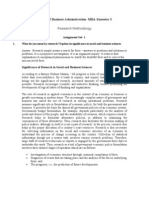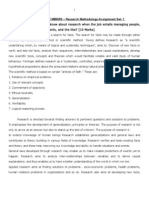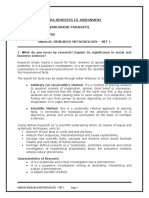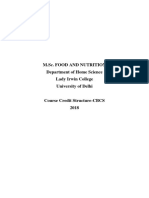Q.1 (A) : Explain The Types of Research
Q.1 (A) : Explain The Types of Research
Uploaded by
Raj2013Copyright:
Available Formats
Q.1 (A) : Explain The Types of Research
Q.1 (A) : Explain The Types of Research
Uploaded by
Raj2013Original Description:
Original Title
Copyright
Available Formats
Share this document
Did you find this document useful?
Is this content inappropriate?
Copyright:
Available Formats
Q.1 (A) : Explain The Types of Research
Q.1 (A) : Explain The Types of Research
Uploaded by
Raj2013Copyright:
Available Formats
Q.1 (a): Explain the types of research.
Ans: Research may be very broadly defined as systematic gathering of data and information and its analysis for advancement of knowledge in any subject. research attempts to find answer intellectual and practical questions through application of systematic methods. Types of research can be classified in many different ways. some major ways of classifying research include the following.
Descriptive versus Analytical Research Applied versus Fundamental Research Qualitative versus Quantitative Research Conceptual versus Empirical Research Descriptive research concentrates on finding facts to ascertain the nature of something as it exists. In contrast analytical research is concerned with determining validity of hypothesis based on analysis of facts collected. Applied research is carried out to find answers to practical problems to be solved and as an aid in decision making in different areas including product design, process design and policy making. Fundamental research is carried out as more to satisfy intellectual curiosity, than with the intention of using the research findings for any immediate practical application. Quantitative research studies such aspects of the research subject which are not quantifiable, and hence not subject to measurement and quantitative analysis. In contrast quantitative research make substantial use of measurements and quantitative analysis techniques. Conceptual research is involves investigation of thoughts and ideas and developing new ideas or interpreting the old ones based on logical reasoning. In contrast empirical research is based on firm verifiable data collected by either observation of facts under natural condition or obtained through experimentation.
-1-
Q1 (b): What is the significance of research in social and business sciences? Ans: Significance of Research in Social and Business Sciences According to a famous Hudson Maxim, All progress is born of inquiry. Doubt is often better than overconfidence, for it leads to inquiry, and inquiry leads to invention. It brings out the significance of research, increased amounts of which makes progress possible. Research encourages scientific and inductive thinking, besides promoting the development of logical habits of thinking and organization. The role of research in applied economics in the context of an economy or business is greatly increasing in modern times. The increasingly complex nature of government and business has raised the use of research in solving operational problems. Research assumes significant role in formulation of economic policy, for both the government and business. It provides the basis for almost all government policies of an economic system. Government budget formulation, for example, depends particularly on the analysis of needs and desires of the people, and the availability of revenues, which requires research. Research helps to formulate alternative policies, in addition to examining the consequences of these alternatives. Thus, research also facilitates the decision making of policy-makers, although in itself it is not a part of research. In the process, research also helps in the proper allocation of a countrys scare resources. Research is also necessary for collecting information on the social and economic structure of an economy to understand the process of change occurring in the country. Collection of statistical information though not a routine task, involves various research problems. Therefore, large staff of research technicians or experts is engaged by the government these days to undertake this work. Thus, research as a tool of government economic policy formulation involves three distinct stages of operation which are as follows: Investigation of economic structure through continual compilation of facts Diagnoses of events that are taking place and the analysis of the forces underlying them; and The prognosis, i.e., the prediction of future developments Research also assumes a significant role in solving various operational and planning problems associated with business and industry. In several ways, operations research, market research, and motivational research are vital and their results assist in taking business decisions. Market research is refers to the investigation of the structure and development of a market for the formulation of efficient policies relating to purchases, production and sales. Operational research relates to the application of logical, mathematical, and analytical techniques to find solution to business problems such as cost minimization or profit maximization, or the -2-
optimization problems. Motivational research helps to determine why people behave in the manner they do with respect to market characteristics. More specifically, it is concerned with the analyzing the motivations underlying consumer behaviour. All these researches are very useful for business and industry, which are responsible for business decision making. Research is equally important to social scientist for analyzing social relationships and seeking explanations to various social problems. It gives intellectual satisfaction of knowing things for the sake of knowledge. It also possesses practical utility for the social scientist to gain knowledge so as to be able to do something better or in a more efficient manner. This, research in social sciences is concerned with both knowledge for its own sake, and knowledge for what it can contribute to solve practical problems.
-3-
Q2: What is meant by validity? How does it differ from reliability and what are its types? Ans: Validity - This means that a measurement scale should measure what it is supposed to measure. Validity may be classified into different types, as described below. The degree of validity of each type is determined by applying logic, statistical procedures or both. 1. Content validity: This type of validity may be of two types - a) Face validity and b) Sampling validity. Face validity is determined through a subjective evaluation of a measuring scale. For example, a researcher may develop a scale to measure consumer attitudes towards a brand and pre-test the scale among a few experts. If the experts are satisfied with the scale, the researcher may conclude that the scale has face validity. However, the limitation of this type of validity is that it is determined by opinions, rather than through a statistical method. Sampling validity refers to how representative the content of the measuring instrument is. In other words, the measuring instrument's content must be representative of the content universe of the characteristic being measured. For example, if attitude is the characteristic being measured, its content universe may comprise statements and questions indicating which aspects of attitude need to be measured. In this case, sampling validity will be determined by comparing the items in the measuring instrument with the items in the content universe. Sampling validity, like face validity, is also based on the judgment and subjective evaluation of both the researcher and outside experts. The determination of the content universe and the selection of the relevant items that are to be included in the measuring scale are both done based on the knowledge and skill of the investigator and other judges.2. Predictive validity: This type of validity refers to the extent to which one behavior can be predicted based on another, based on the association between the results yielded by the measuring instrument and the eventual outcome.3. Construct validity: A construct is a conceptual equation that is developed by the researcher based on theoretical reasoning. Various kinds of relationships may be perceived by the researcher between a variable under study and other variables2.4.2 Reliability This refers to the ability of a measuring scale to provide consistent and accurate results. To give a simple example, a weighing machine may be said to be reliable if the same reading is given every time the same object is weighed.
-4-
Q3: (a): Why literature survey is important in research? Ans:
-5-
Q3 (b): What are the criteria of good research problem? Ans: A good research problem must support multiple perspectives. The problem most be phrased in a way that avoids dichotomies and instead supports the generation and exploration of multiple perspectives. A general rule of thumb is that a good problem is one that would generate a variety of viewpoints from a composite audience made up of reasonable people. A good research problem must be researchable. It seems a bit obvious, but more than one instructor has found herself or himself in the midst of a complex collaborative research project and realized that students don't have much to draw on for research, nor opportunities to conduct sufficient primary research. Choose research problems that can be supported by the resources available to your students.
Umbrella topics must be sufficiently complex. If you are using an umbrella topic for a large class of students who will be working on related, more manageable problems in their learning teams, make sure that there is sufficient complexity in the research problems that the umbrella topic includes. These research topics must relate strongly to one another in such a way that there will be a strong sense of coherence in the overall class effort.
-6-
Q.4: Explain the procedure for Testing Hypothesis Ans: 1) Observe, gather information about your topic completely objectively without trying to explain anything, THEN formulate a hypothesis which seems to explain everything you have observed. Then you can test your hypothesis. A good hypothesis will not only explain things, but will also have predictive value. By using these predictions, formulate experiments designed to test how accurate these predictions are. For example, after observing sunspots for a few decades you might notice they seem to occur in 11 year cycles. You could turn this into a hypothesis describing the nature of these cycles, then use it to predict these apparent cycles would continue with future observation: a very simple example. You need to then perform your experiment in as objective a manner as you possibly can: control as many variables as you can, so you are only testing the relationship you are actually trying to, and be very rigorous and honest with all measurements and observations.
If enough experiments or further observation supports your hypothesis, and if others can easily replicate your results (if only you get supportive results, it looks VERY suspicious and people tend not to believe you....), then it comes to be called a "theory", which is a well-supported hypothesis. It never gets promoted to the level of "fact"..... gravity is still referred to as a "theory".
-7-
Q.5 (a): Explain the components of a research design. Ans: Generalization Control Manipulation Comparison The Research Question B) The Theory C) The Model D) The Data E) The Use of the Data The key components of research design apply to all types of qualitative, deductive research, whether in the physical or social sciences. These components include theory, hypothesis, choosing an experimental design and collecting data, analyzing data, reporting the results and refining the theory. Different types of research call for different experimental designs, such as laboratory tests for a biochemical research project, or a questionnaire or survey for marketing research. Theory and Hypothesis
A theory is the over-reaching concept behind the research. In this first step, the researcher looks at previous research and literature about the problem at hand. An example of a theory would be a statement, such as "living with a partner is healthier than living alone." An hypothesis is a testable statement based upon the theory. For example, an hypothesis could be "people living with partners have lower blood pressure than those living alone." Data Collection and Research Design
After the hypothesis is defined, the researcher then decides how to collect data. Each type of experimental design has advantages and disadvantages. Questionnaires are cheap to distribute, but the sample returned will not be random. RD Info stresses the importance of a random sample. Random samples ensure that the results of the study are not skewed due to the makeup of the test group. Experimental designs suffer when conducted in an artificial environment. Drug tests involve many ethical issues, such as withholding a promising drug from a control -8-
group with a disease. The number of participants needed depends on the number of variables tested. Using the hypothesis above regarding couples and blood pressure, the variables tested would include blood pressure, the presence of a partner, age, marital status, general health, length of relationship, sex and income. Statistical Analysis and Reporting
A statistical analysis will determine if the findings of the study support the hypothesis. A variety of statistical tests, such as T-tests (which measure if two groups are statistically different from each other), Chi-square tests (where data are compared to an expected outcome) and one-way analysis of variance (allows for the comparison of multiple groups), are conducted depending on the type of data, number and types of variables and data categories. Reporting of findings in scientific journals and other venues enables others to learn from and critique the research. Revision of the Theory
If the hypothesis about living with a partner can lead to lower blood pressure was found to be statistically significant for older adults but not for younger ones, the theory that led to the hypothesis would need to be revised to take the new finding into account. The original theory would be revised to state: "for older adults, living with a partner is healthier than living alone." In this way, science builds upon and refines knowledge.
-9-
Q.5 (b). Briefly explain the different types of research designs. Ans: Primary research This collects data that does not already exist. Survey, questionnaire, interview, observation. Secondary research This looks at existing data. It may be a summary, collation or synthesis of information. Qualitative research Looks at what humans behaviour and the reasons behind it. What people do and why. Quantitative Quantitative research systematic empirical investigation quantitative properties. How many people do these things and how often.
- 10 -
Q6 (a): What are the assumptions of Case Study Method? Ans:
- 11 -
Q6 (b): Explain the Sampling Process. Ans: The sampling techniques may be broadly classified into: 1. Probability sampling Non-probability sampling Probability Sampling: Probability sampling provides a scientific technique of drawing samples from the population. The technique of drawing samples is according to the law in which each unit has a probability of being included in the sample. 1.1. Simple random sampling 1.1.1. Under this technique, sample units are drawn in such a way each and every unit in the population has an equal and independent chance of being included in the sample. 1.1.2. If a sample unit is replaced before drawing the next unit, then it is known as simple Random Sampling with Replacement. 1.1.3. If the sample unit is not replaced before drawing the next unit, then it is case, probability of drawing a unit is 1/N, where N is the population size. In the case probability of drawing a unit is 1/Nn. 1.2. Stratified random sampling 1.2.1. This sampling design is most appropriate if the population is heterogeneous with respect to characteristic under study or the population distribution is highly skewed. Table: Merits and demerits of stratified random sampling Merits Sample is more representative Provides more efficient estimate Administratively more convenient Can be applied in situation where different degrees of accuracy is desired for different segments of population - 12 De-Merits Many times the stratification is not effective Appropriate sample sizes are not drawn from each of the stratum
1.3. Systematic sampling 1.3.1. This design is recommended if we have a complete list of sampling units arranged in some systematic order such as geographical, chronological or alphabetical order. Table: Merits and demerits of systematic sampling Merits Very easy to operate and easy to check It saves time and labour More efficient than simple random sampling if we have up-to-date frame. 1.4. Cluster sampling 1.4.1. The total population is divided into recognizable sub-divisions, known as clusters such that within each cluster they are homogenous. The units are selected from each cluster by suitable sampling techniques. De-Merits Many case we do not get up-to-date list It gives biased results if periodic feature exist in the data
1.5. Multi-stage sampling 1.5.1. 2. The total population is divided into several stages. The sampling process is carried out through several stages. Non-probability sampling: Depending upon the object of inquiry and other considerations a predetermined number of sampling units is selected purposely so that they represent the true characteristics of the population. 2.1. Judgment sampling The choice of sampling items depends exclusively on the judgment of the investigator. The investigators experience and knowledge about the population will help to select the sample units. It is the most suitable method if the population size is less. Table: Merits and demerits of judgment sampling Merits Most useful for small population Most useful to study some unknown traits of a population some of whose characteristics are known. Helpful in solving day-to-day problems. De-Merits It is not a scientific method. It has a risk of investigators bias being introduced.
- 13 -
2.2. Convenience sampling The sampling units are selected according to convenience of the investigator. It is also called chunk which refer to the fraction of the population being investigated which is selected neither by probability nor by judgment. 2.3. Quota sampling It is a type of judgment sampling. Under this design, quotas are set up according to some specified characteristic such as age groups or income groups. From each group a specified number of units are sampled according to the quota allotted to the group. Within the group the selection of sampling units depends on personal judgment. It has a risk of personal prejudice and bias entering the process. This method is often used in public opinion studies.
- 14 -
You might also like
- Research Methodology Full NotesDocument87 pagesResearch Methodology Full Notesu2b1151785% (253)
- Bhaggo MAX FPSDocument4 pagesBhaggo MAX FPSaliaimeminecraft100% (1)
- Methods of Research: Simple, Short, And Straightforward Way Of Learning Methods Of ResearchFrom EverandMethods of Research: Simple, Short, And Straightforward Way Of Learning Methods Of ResearchRating: 4.5 out of 5 stars4.5/5 (6)
- Mastered and Unmastered CompetencyDocument8 pagesMastered and Unmastered CompetencyBill VillonNo ratings yet
- Mb0050 Smu Project ManagementDocument13 pagesMb0050 Smu Project ManagementAjeeth KumarNo ratings yet
- Assignment - Market ResearchDocument9 pagesAssignment - Market Researchsinghalok1980No ratings yet
- Chapter OneDocument8 pagesChapter OneMuhammed YismawNo ratings yet
- Unit 1 BRMDocument49 pagesUnit 1 BRMAyush SengarNo ratings yet
- Pad 519: Research Method Introductory LECTURE NOTEDocument55 pagesPad 519: Research Method Introductory LECTURE NOTEHunegnaw AynalemNo ratings yet
- Importance of Quantitative Research Across The FieldsDocument6 pagesImportance of Quantitative Research Across The Fieldsjm88% (24)
- Master of Business Administration-MBA Semester 3: Research MethodologyDocument27 pagesMaster of Business Administration-MBA Semester 3: Research MethodologyManishadhingra100% (1)
- Research Methodology MB0050: Q1. A) Explain The Types of ResearchDocument8 pagesResearch Methodology MB0050: Q1. A) Explain The Types of ResearchBhupendra KarandikarNo ratings yet
- MBA-III Semester: Siddhartha Sen Roll Number: 581117638Document23 pagesMBA-III Semester: Siddhartha Sen Roll Number: 581117638Siddhartha SenNo ratings yet
- Mba Semester Iii MB0050 - Research Methodology-4 Credits (Book ID: B1206) Assignment Set - 1 (60 Marks)Document8 pagesMba Semester Iii MB0050 - Research Methodology-4 Credits (Book ID: B1206) Assignment Set - 1 (60 Marks)Rajesh SinghNo ratings yet
- Long Questions 1 - Meaning of Research Objectives and Types of ResearchDocument12 pagesLong Questions 1 - Meaning of Research Objectives and Types of ResearchrajisumaNo ratings yet
- Characteristics, Strengths and Weaknesses, and Types of Qualitative ResearchDocument12 pagesCharacteristics, Strengths and Weaknesses, and Types of Qualitative ResearchRosalyn RayosNo ratings yet
- Prelim 1. Discuss The Significance of Research in EducationDocument6 pagesPrelim 1. Discuss The Significance of Research in EducationSara Jane del RosarioNo ratings yet
- RMDocument27 pagesRMDeepshikha SonberNo ratings yet
- RM Unit 1Document10 pagesRM Unit 1Rekha RawatNo ratings yet
- Assingment 2 BRMDocument9 pagesAssingment 2 BRMApeksha JoglekarNo ratings yet
- Unit 1 RMDocument25 pagesUnit 1 RMShrikant KaleNo ratings yet
- Business Research Methods Question GuideDocument68 pagesBusiness Research Methods Question GuideMiyon100% (1)
- Syndicate Research MethodDocument28 pagesSyndicate Research MethodZahid QureshiNo ratings yet
- Question 1:-What Do You Mean by Research? Explain Its Significance in Social and Business Sciences. AnswerDocument32 pagesQuestion 1:-What Do You Mean by Research? Explain Its Significance in Social and Business Sciences. Answersaurabh_rtlNo ratings yet
- Mba Research Methology 1Document9 pagesMba Research Methology 1Arun KumarNo ratings yet
- Objectives of Research: Hypothesis-Testing Research Studies: To Test A Hypothesis of A Causal RelationshipDocument8 pagesObjectives of Research: Hypothesis-Testing Research Studies: To Test A Hypothesis of A Causal RelationshipAnto C JoseNo ratings yet
- RM ProjectDocument35 pagesRM ProjectKinjalBhadreshwaraNo ratings yet
- BRM Unit 1Document28 pagesBRM Unit 1Ruhi KumariNo ratings yet
- Research MethodologyDocument43 pagesResearch Methodologytechbyte009No ratings yet
- Wa0038Document48 pagesWa0038Harish hari gombeNo ratings yet
- 08 - Chapter 5Document23 pages08 - Chapter 5Sakshi MishraNo ratings yet
- Master of Business Administration - MBA Semester 3 (Book ID: B1206) Assignment Set-1Document9 pagesMaster of Business Administration - MBA Semester 3 (Book ID: B1206) Assignment Set-1Pradeep KrNo ratings yet
- What Is The Significance of Research in Social and Business Sciences?Document7 pagesWhat Is The Significance of Research in Social and Business Sciences?sid007.earth6327No ratings yet
- Research MethodologyDocument58 pagesResearch Methodologytripathi_indramani5185No ratings yet
- Research Methods NotesDocument20 pagesResearch Methods Notessunil_birman100% (3)
- Research Design and ApproachDocument8 pagesResearch Design and ApproachNati TesfayeNo ratings yet
- What Do U Understand by Research and Research MethodDocument14 pagesWhat Do U Understand by Research and Research MethodMOH VlogsNo ratings yet
- Business Research MethodDocument25 pagesBusiness Research MethodManishNo ratings yet
- Module 1 - Research Properties and Its TypesDocument10 pagesModule 1 - Research Properties and Its Typeshemanthkumar40680No ratings yet
- Module 1 - Introduction To Research N1UDmJDDzZDocument17 pagesModule 1 - Introduction To Research N1UDmJDDzZzenobia.surNo ratings yet
- Research MethodologyDocument12 pagesResearch MethodologyshankruthNo ratings yet
- Chapter 1 EditedDocument14 pagesChapter 1 EditedabibualNo ratings yet
- BRM - MODULE 1 Presentation 1Document18 pagesBRM - MODULE 1 Presentation 1muneerpp100% (1)
- characteristics and types of researchDocument6 pagescharacteristics and types of researchradhegovind1491981No ratings yet
- CHAPTER FOUR - Research Design: Learning ObjectivesDocument13 pagesCHAPTER FOUR - Research Design: Learning ObjectivesHayelom Tadesse GebreNo ratings yet
- Basic Research and Applied ResearchDocument4 pagesBasic Research and Applied ResearchHundeNo ratings yet
- Research TypesDocument15 pagesResearch TypesStaff oumlilNo ratings yet
- Mba Semester Iii Assignment Name: George Varughese Paradayil ROLL NO.: 530910788 Mb0035: Research Methodology - Set 1Document15 pagesMba Semester Iii Assignment Name: George Varughese Paradayil ROLL NO.: 530910788 Mb0035: Research Methodology - Set 1image_2010No ratings yet
- Arm - Module 2Document4 pagesArm - Module 2Angela Tibagacay CaballeroNo ratings yet
- Unit-1 Research MethodologyDocument17 pagesUnit-1 Research MethodologyRajakumar RampalliNo ratings yet
- Consumer Behaviour - MKT 531, MBM (Third Semester) UNIT - 4 Consumer ResearchDocument10 pagesConsumer Behaviour - MKT 531, MBM (Third Semester) UNIT - 4 Consumer ResearchUmesh kathariyaNo ratings yet
- BSM Unit-I NotesDocument20 pagesBSM Unit-I NotesMamilla Naveen Kumar ReddyNo ratings yet
- MB0034 Research MethodologyDocument26 pagesMB0034 Research Methodologypriyanka_4184No ratings yet
- Quantitative ResearchDocument6 pagesQuantitative Researchceedosk1No ratings yet
- Foundations of ResearchDocument6 pagesFoundations of Researchpayalbhol055No ratings yet
- Research Methodology - IntroductionDocument23 pagesResearch Methodology - IntroductionDrPreeti JindalNo ratings yet
- Research Proposal a Simplified Step-by-Step Guide - Revised EditionFrom EverandResearch Proposal a Simplified Step-by-Step Guide - Revised EditionNo ratings yet
- Participatory Action Research for Evidence-driven Community DevelopmentFrom EverandParticipatory Action Research for Evidence-driven Community DevelopmentNo ratings yet
- Activity Based Costing (ABC) : 7 QC ToolsDocument16 pagesActivity Based Costing (ABC) : 7 QC ToolsManas DasguptaNo ratings yet
- c4.1 Populations and CommunitiesDocument50 pagesc4.1 Populations and Communitieshimangani2007jadonNo ratings yet
- K To 12 MELC Statistics and ProbabilityDocument5 pagesK To 12 MELC Statistics and ProbabilityPrincess Ork Tee100% (4)
- CH 01Document21 pagesCH 01Nesya JanesyaNo ratings yet
- MPC 06 Yashvender Kota - 241104 - 231401Document96 pagesMPC 06 Yashvender Kota - 241104 - 231401Yashvendra Singh RaghavNo ratings yet
- Sandeep's Fine Project On Celebrity Endorsement As A Source of Brand BuildingDocument74 pagesSandeep's Fine Project On Celebrity Endorsement As A Source of Brand Buildingsandy80% (5)
- Kolmogorov-Smirnov D TableDocument2 pagesKolmogorov-Smirnov D TableAndreea CNo ratings yet
- A Study On Employee Absenteeism at TVS Sundaram Fasteners Limited, Chennai, TamilnaduDocument7 pagesA Study On Employee Absenteeism at TVS Sundaram Fasteners Limited, Chennai, TamilnaduIJRASETPublicationsNo ratings yet
- LIC - Home Science PDFDocument628 pagesLIC - Home Science PDFRahul ChaudharyNo ratings yet
- EPGP in Data Science Gen AI PDFDocument63 pagesEPGP in Data Science Gen AI PDFkulkarnivshNo ratings yet
- A Study On Consumer Satisfaction Towards Jio NetworkDocument32 pagesA Study On Consumer Satisfaction Towards Jio NetworkAjmal Roshan100% (1)
- Chapter 1 General OverviewDocument43 pagesChapter 1 General OverviewAbhishiktaAbhiNo ratings yet
- Chapter 4 Hypotheses Testing of More Than Two PopulationsDocument90 pagesChapter 4 Hypotheses Testing of More Than Two PopulationsGAYATHIRI MUNIANDYNo ratings yet
- 2022 TAKE-HOME Test Hyunuk SeungDocument4 pages2022 TAKE-HOME Test Hyunuk SeungGaurav PatilNo ratings yet
- Parametric and NonParametric Tests - 3Document20 pagesParametric and NonParametric Tests - 3udaylpu9No ratings yet
- Computation of Test Statistic On Population MeanDocument27 pagesComputation of Test Statistic On Population Meannot deniseNo ratings yet
- Prof. Joy V. Lorin-Picar Davao Del Norte State College: New Visayas, Panabo CityDocument91 pagesProf. Joy V. Lorin-Picar Davao Del Norte State College: New Visayas, Panabo CityJeLo ReaNdelarNo ratings yet
- Brief History of StatisticsDocument20 pagesBrief History of Statisticssheena bertolanoNo ratings yet
- Minitab PowerPointDocument133 pagesMinitab PowerPointCarmenElenaAntonNo ratings yet
- Null Hypothesis ExamplesDocument2 pagesNull Hypothesis ExampleslilyNo ratings yet
- Jurnal Brand Ex London PDFDocument333 pagesJurnal Brand Ex London PDFWinta ChrislindaNo ratings yet
- Minimum Sample For Diagnostic TestDocument6 pagesMinimum Sample For Diagnostic TestLulu DjalilNo ratings yet
- New Drug Development, Design, Methodology and Analysis - Turner JR (Ed) - 2007Document297 pagesNew Drug Development, Design, Methodology and Analysis - Turner JR (Ed) - 2007Ismi Rahmawati100% (6)
- Statistics Part 5 and 6Document3 pagesStatistics Part 5 and 6api-311379563No ratings yet
- Nm2103 Week 1 IvleDocument32 pagesNm2103 Week 1 IvleChiew Jun SiewNo ratings yet
- Impor 2014Document151 pagesImpor 2014SoùFian AitNo ratings yet
- Faculty of Science M.Sc. / M.A. (Statistics)Document3 pagesFaculty of Science M.Sc. / M.A. (Statistics)Gaurav VarshneyNo ratings yet

























































































